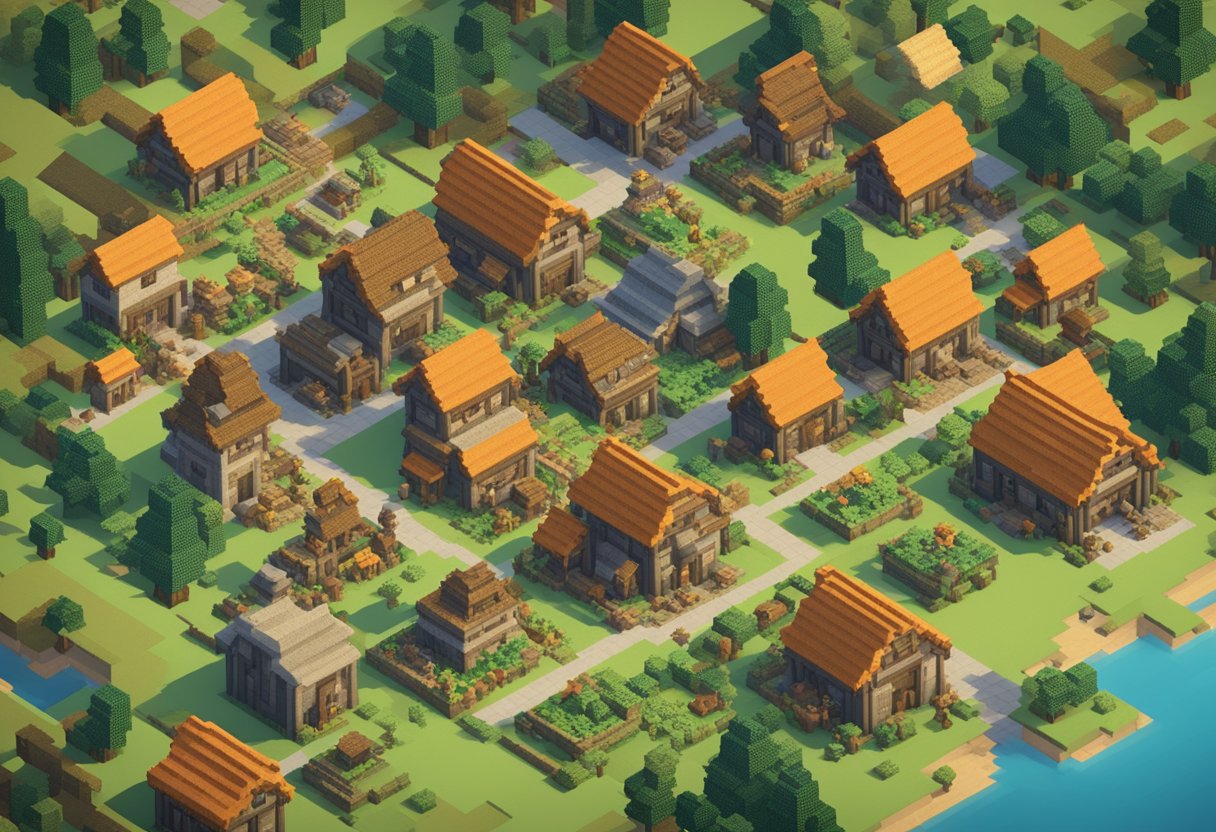Types Of Villagers in Minecraft
Villagers are non-player characters that inhabit Minecraft villages. They are essential to the game’s economy and provide a variety of services, including trading and farming. There are several types of villagers in Minecraft, each with its own unique set of skills and abilities.
One of the most important aspects of villagers is their professions. Villagers can have one of several professions, including farmer, librarian, and blacksmith. Each profession has its own set of skills and abilities, which can be used to trade with players. For example, farmers can trade crops and other food items, while blacksmiths can trade weapons and armor.
Another important aspect of villagers is their trading system. Villagers use emeralds as currency, which can be obtained by trading with players or by completing tasks for the villagers. Players can trade various items with villagers, including food, weapons, and armor. The trading system is an essential part of the game’s economy and allows players to obtain valuable items that are difficult to find otherwise.
Key Takeaways
- Villagers in Minecraft have unique professions and abilities that can be used to trade with players.
- The trading system in Minecraft is an essential part of the game’s economy and allows players to obtain valuable items.
- Villagers are essential to the game’s social structure and provide players with a variety of services.
Villager Professions

In Minecraft, villagers are passive mobs that inhabit villages and work at their respective professions. They can be found in various biomes and can interact with each other. Villagers can trade with players using emeralds as currency, and they offer a variety of items that are useful for players to survive and thrive in the game. Villagers also have a social structure within their villages, and their professions play a crucial role in maintaining their society.
Farmer
Farmers are one of the most common professions of villagers. They can be identified by their brown robes and straw hats. They are responsible for growing and harvesting crops, such as wheat, carrots, and potatoes. They offer various food items, including bread, to players in exchange for emeralds. Players can also sell their own crops to farmers for emeralds. Farmers can use composters to turn excess crops into bone meal, which can be used to grow more crops.
Librarian
Librarians are another common profession of villagers. They can be identified by their white robes and black glasses. They offer a variety of enchanted books that can be used to enhance player’s gear, tools, and weapons. They also offer regular books that can be used to create bookshelves and lecterns. Players can trade emeralds and sometimes experience points for these items.
Armorer
Armorers are villagers that specialize in creating and selling armor. They can be identified by their black aprons and gray hats. They offer various types of armor, including iron and diamond armor, in exchange for emeralds. Armorers can use blast furnaces to smelt iron ingots faster than regular furnaces.
Weaponsmith
Weaponsmiths are villagers that specialize in creating and selling weapons. They can be identified by their brown aprons and black hats. They offer various types of weapons, including swords and axes, in exchange for emeralds. Weaponsmiths can use grindstones to repair and disenchant weapons.
Toolsmith
Toolsmiths are villagers that specialize in creating and selling tools. They can be identified by their white aprons and black hats. They offer various types of tools, including pickaxes and shovels, in exchange for emeralds. Toolsmiths can use smithing tables to upgrade tools to higher tiers.
Butcher
Butchers are villagers that specialize in selling food items. They can be identified by their white aprons and red hats. They offer various types of food, including cooked meat, in exchange for emeralds.
Fletcher
Fletchers are villagers that specialize in creating and selling bows and arrows. They can be identified by their green aprons and brown hats. They offer various types of bows and arrows in exchange for emeralds. Fletchers can use fletching tables to create more advanced arrows.
Fisherman
Fishermen are villagers that specialize in selling fish and other fishing-related items. They can be identified by their blue aprons and white hats. They offer various types of fish, including salmon and pufferfish, in exchange for emeralds. Fishermen can also use barrels to store fish and other items.
Shepherd
Shepherds are villagers that specialize in selling wool and other related items. They can be identified by their white aprons and blue hats. They offer various types of wool in exchange for emeralds. Shepherds can also use looms to create more advanced wool-related items, such as banners.
Cartographer
Cartographers are villagers that specialize in selling maps and other exploration-related items. They can be identified by their white robes and gray hats. They offer various types of maps, including treasure maps and exploration maps, in exchange for emeralds. Cartographers can also use cartography tables to create more advanced maps.
Cleric
Clerics are villagers that specialize in selling magical items and potions. They can be identified by their purple robes and white collars. They offer various types of potions, including ones that can be used to heal players or grant them special abilities, in exchange for emeralds. Clerics can use brewing stands to create more advanced potions, and they can also use glowstone to enhance the effects of their potions.
Leatherworker
Leatherworkers are villagers that specialize in selling leather and other leather-related items. They can be identified by their white aprons and brown hats. They offer various types of leather in exchange for emeralds. Leatherworkers can also use cauldrons to dye leather and create more advanced leather-related items.
Mason
Masons are villagers that specialize in selling stone and other building materials. They can be identified by their white aprons and brown hats. They offer various types of stone, including cobblestone and stone bricks, in exchange for emeralds. Masons can also use stonecutters to create more advanced stone-related items.
Nitwit
Nit
Villager Trading System
Minecraft’s Villager Trading System is a unique and exciting feature that allows players to trade with villagers for various items. This system is a popular way to obtain rare and valuable items, such as enchanted weapons, food, tools, brewing stands, maps, arrows, banners, paintings, name tags, flint, and more.
Trading Mechanics
To start trading with a villager, players must first locate a village and find a villager. Once a player has found a villager, they can interact with them to open the trading interface. In this interface, players can see the items that the villager has available for trade, as well as the items that the player can offer in exchange.
Each villager has a set of trades that they offer, which can vary depending on the villager’s profession and level. Villagers have five levels of each profession: Novice, Apprentice, Journeyman, Expert, and Master. The higher the villager’s level, the more options for trade the player has. The easiest way to level up a villager for more trading options is to trade with them. The more a player trades, the more experience the villager will get.
Tradeable Items
The items that a player can trade with a villager can vary depending on the villager’s profession and level. However, some items are commonly available for trade, such as emeralds, which are the primary currency used in the trading system.
Other tradeable items include weapons, food, tools, brewing stands, maps, arrows, banners, paintings, name tags, flint, and more. Each villager has a unique set of items that they offer for trade, so players should explore different villages to find the items they need.
Economy and Currency
The economy of the villager trading system is based on a barter system, where players offer items in exchange for other items. The primary currency used in the trading system is emeralds, which players can obtain by trading with villagers or by mining emerald ore.
Players can use emeralds to purchase various items from villagers, such as weapons, food, tools, brewing stands, maps, arrows, banners, paintings, name tags, flint, and more. The value of each item varies depending on the villager’s profession and level, so players should be strategic about which items they trade for.
Overall, the Villager Trading System is an exciting and unique feature in Minecraft that adds depth and complexity to the game’s economy. Players can use this system to obtain rare and valuable items, as well as to level up their villager trading partners for even more trading options.
Villager Behavior and Social Structure
Daily Activities
Villagers in Minecraft have a set of daily routines that they follow. During the day, they will go to their designated workstations and perform their jobs, such as farming, crafting, or trading. When night falls, they will seek shelter and sleep in their beds to avoid danger. In the morning, they will wake up and resume their daily tasks.
Social Interactions
Villagers are social creatures and interact with each other in various ways. They will greet each other with a “hello” or “good morning” when they pass by. They also have a gossip system, which allows them to share information with each other. Villagers will also throw bread at each other as a form of sharing food.
Breeding and Population
Villagers can breed and produce baby villagers. To do so, they need to have access to a bed and a bell. The bell serves as a signal for the villagers to gather together and celebrate a successful breeding. As the population of a village grows, new houses and workstations will be built to accommodate the new villagers.
Overall, the social structure of a village in Minecraft is based on the interactions between the villagers and their daily routines. By providing them with the necessary resources and tools, players can help the villagers thrive and grow their population.
Villager Interaction with Players
Trading with Players
Villagers in Minecraft are an essential part of the gameplay, and players can trade with them using emeralds as currency. Different types of villagers offer various items in exchange for emeralds, such as food, weapons, and armor. Players can also level up their trading by completing trades with the same villager multiple times.
To trade with a villager, players must first locate a village and find a villager with the desired trade. Once a player has found the right villager, they can right-click on the villager to open the trading interface. The interface displays all the available trades and the cost in emeralds for each trade. Players can hover over each trade to see the item they will receive in exchange for emeralds.
Trading with villagers is an excellent way for players to obtain valuable items that they may not be able to craft themselves. It’s also a great way for players to earn emeralds, which can be used to trade with other villagers or purchase items from wandering traders.
Villager Help in Defense
Villagers can also help players defend against hostile mobs. When a village is under attack, iron golems will spawn to protect the villagers. Players can also help defend the village by building walls, lighting up the area, and creating traps for hostile mobs.
During a raid, players can also enlist the help of the villagers. Villagers will hide in their homes during a raid, but players can encourage them to fight by giving them weapons. Villagers armed with weapons can be a valuable asset during a raid, as they can help players defend against the raiders.
In conclusion, the interaction between villagers and players in Minecraft is crucial to the gameplay. Trading with villagers using emeralds as currency is an excellent way for players to obtain valuable items and level up their trading. Villagers can also help players defend against hostile mobs during a raid, making them a valuable asset in the game.
Threats to Villagers
Villagers in Minecraft face a number of threats that can put their safety at risk. These threats include zombie attacks, illager raids, and environmental dangers. It is important for players to be aware of these threats and take steps to defend their villages and protect their villagers.
Zombie Attacks
Zombies are one of the most common threats to villagers in Minecraft. These hostile mobs will attack villagers on sight, and can quickly overwhelm an unprepared village. To defend against zombie attacks, players should ensure that their villages are well-lit, and that villagers have access to safe areas where they can hide at night. It is also a good idea to build walls or other barriers around the village to keep zombies out.
Illager Raids
Illagers are another threat to villagers in Minecraft. These hostile mobs will often launch raids on villages, attacking villagers and attempting to steal valuable items. To defend against illager raids, players should be prepared to fight back with weapons such as swords and crossbows. It is also a good idea to ring the village bell to alert villagers to the danger, and to build defensive structures such as walls or towers.
Environmental Dangers
In addition to zombie attacks and illager raids, villagers in Minecraft can also be threatened by environmental dangers. These include things like fires, floods, and other natural disasters. To protect against these dangers, players should build their villages in safe areas, such as on high ground or in biomes that are less prone to environmental hazards. They should also be prepared to quickly evacuate villagers if necessary.
Overall, it is important for players to take the safety of their villagers seriously in Minecraft. By being aware of the threats they face and taking steps to defend against them, players can help ensure that their villages thrive and their villagers remain safe.






